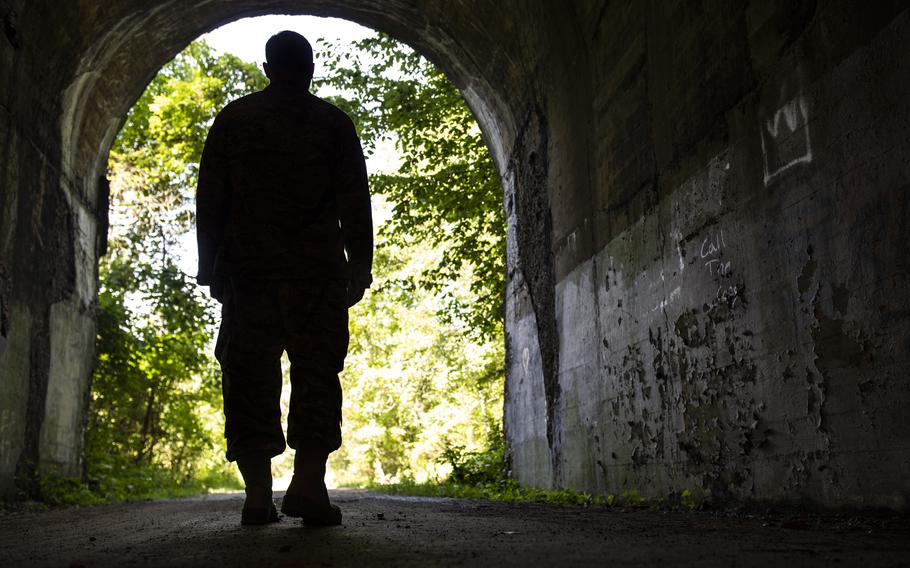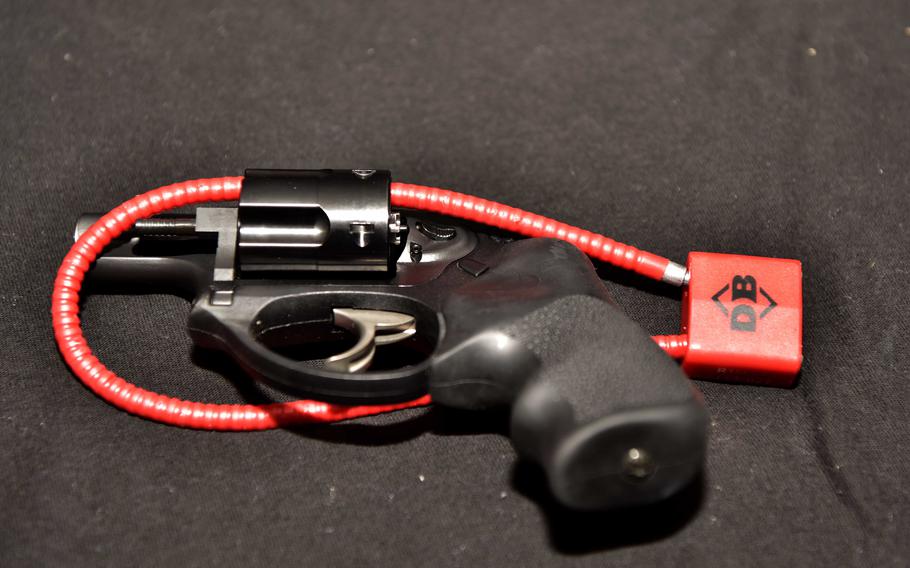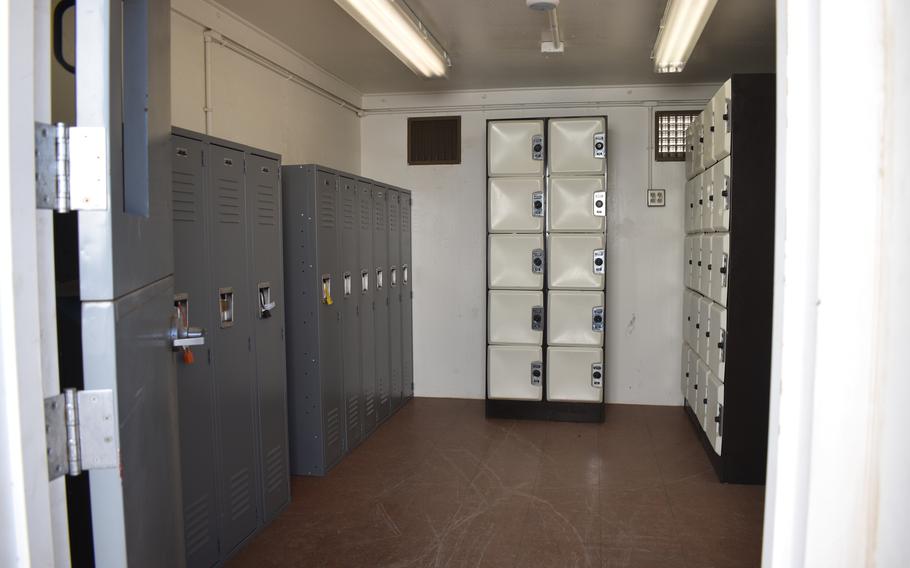
The Defense Department’s Suicide Prevention and Response Independent Review Committee, a group convened by Defense Secretary Lloyd Austin in 2022 to find ways to reverse a 15-year upward trend in military suicides, released a report Friday, Feb. 24, 2023, that makes several recommends to help reduce suicides among service members including a limit to firearm access. (Joshua J. Seybert/U.S. Air Force)
Megan Powell didn’t know her husband, then an Army major, had been having thoughts of suicide until he came to her and asked her to lock up the family’s firearms so he didn’t have access to them.
That was two years ago while he was assigned to Fort Hood in Texas. The couple had been arguing that night before she’d finally given up and gone to bed. Her husband came to her later at about 10 p.m. with the request.
“If I don’t say this right now, I’m not ever going to say it,” Powell, 40, recalled him telling her.
Her husband, who requested he not be named, then began to describe a crisis safety plan that he and his therapist had discussed. This was the first time that Powell had learned her husband, who was being treated for post-traumatic stress disorder, had experienced thoughts of suicide and she was part of the plan to save him in a crisis.
She did what he asked of her and locked up the guns.
The Defense Department released a report Friday examining the suicide crisis in the military. In it, the department’s Suicide Prevention and Response Independent Review Committee made six recommendations that target safe firearms storage education for troops, better access to gun storage and locks, mandatory registration and storage requirements for personnel living in military family housing.
Reducing access to firearms has helped reduce suicide deaths and improved survival rates of suicide attempts, according to the committee’s report, which includes 117 recommendations that stretch beyond safe firearm storage.
Statistics show about two-thirds of all military personnel and veterans who die by suicide use a gun, said Craig Bryan, an Air Force veteran and clinical psychologist with an expertise in suicide prevention.
In the National Guard that statistic is closer to 80%, said Bryan, who is also a member of the Defense Department committee.
“It's really hard to talk about suicide prevention meaningfully if we're not talking about the role of firearms play,” he said.
The crisis stretches to veterans, too. The Department of Veterans Affairs began providing free gun locks to veterans in 2008. Since then, it has handed out more than 852,000 cable gun locks.
The Navy and National Guard since have begun similar lock distribution programs.
Congress mandated in the 2023 National Defense Authorization Act, an annual bill that outlines defense priorities and spending, that the Defense Department create a pilot program to expand access to gun locks for troops. The Pentagon has until the end of the year to send a plan to Congress about how it will distribute locks and where.
At Fort Carson, Colo., the post’s Morale, Welfare and Recreation program opened a firearm storage rental facility at its on-base shooting range to create more gun safety options.
“This started as a way to help prevent suicides,” said Col. Sean Brown, Fort Carson garrison commander.

A .357 magnum is displayed with a gun lock. The Defense Department released a report Friday, Feb. 24, 2023, examining the suicide crisis in the military. In it, the department’s Suicide Prevention and Response Independent Review Committee made six recommendations that target safe firearms storage education for troops, better access to gun storage and locks, mandatory registration, and storage requirements for personnel living in military family housing. (Beaux Hebert/U.S. Air Force)
Reframing prevention
Congress mandated the Pentagon review suicide prevention in the 2022 National Defense Authorization Act because suicide deaths among service members have gradually increased in the previous decade.
However, deaths by suicide did drop 15% in 2021 from the previous year, according to a 2022 Pentagon report on suicide deaths, the most recent data available.
“While we are cautiously encouraged by the drop in these numbers, one year is not enough time to assess real change,” Beth Foster, the executive director of the Pentagon's Force Resiliency Office, told reporters in October when the report was released.
In 2021, the active-duty suicide death rate was 24 deaths per 100,000 service members. The previous year was 29 per 100,000, according to the report.
Even with the drop, the rate remains higher than that of the general U.S. population, which was 13.5 per 100,000 in 2020, according to the Centers for Disease Control and Prevention.
More so, of the 519 active duty, National Guard and Reserve personnel who died by suicide in 2021, 364 of those troops used a firearm, according to data provided in the DOD committee’s report.
Megan Powell described the night that her husband asked her to lock up their guns as one of the most isolating moments of the couple’s struggles.
“It was like, I have no idea what I am supposed to do right now other than take this key and make sure he doesn't have access to it,” she said. "It makes it harder at home because suddenly I'm looking at my husband in a completely different light. For a few weeks there, every little thing that was off with him was magnified 10 times because it was like, ‘OK, what are you thinking right now?’”
Powell locked the family’s firearms in a safe and hid the key from her husband. Still recovering, her husband has since medically retired from the Army. Had he not been willing to discuss something so difficult with her, she said she would not have known that limiting his access to the guns was a potentially lifesaving action.
Bryan said people working in prevention have long focused on why people die by suicide. There’s not one answer. Instead, he said he started to look at how people die and identify safety measures that can be implemented to prevent those deaths, which is a theme in his 2021 book “Rethinking Suicide: Why Prevention Fails and How We Can Do Better.”
About half of those who die by suicide have a mental health condition, Bryan said. That statistic holds true in the military as well and was thought to exist because of the apprehension among service members to seek out mental health care, he said.
However, Bryan said there’s a significant percentage of people who are experiencing an extreme reaction to a moment of severe stress, such as relationship problems, financial strain and legal issues.
"They get stressed really fast, they get overwhelmed and particularly if they have access to a highly lethal methods like a loaded weapon, that transient temporary moment of despair is weaponized,” he said. “Most of us have experienced this before. We've lost our temper. ... We’ve made a decision that we wish we can take back. I think for many people, this is how they experience suicide risk, and it doesn't require a mental illness to have those types of natural human responses.”

Fort Carson, Colo., opened a storage facility in August where soldiers can rent lockers to store their personally owned firearms. The idea for the facility is an effort to prevent suicide deaths, base officials said. (Photo provided by Fort Carson)
Beyond gun locks
The Fort Carson firearm storage facility has leased four lockers since it opened six months ago at the Cheyenne Mountain Shooting Complex, Brown said.
He said he expects usage to grow as soldiers become aware of the new facility. It’s being touted as an alternative for anyone who lives in the barracks where personal weapons are not allowed, soldiers who don’t want to keep their weapon in their home or soldiers who are deploying overseas.
"If somebody doesn't have the means to go out and purchase a proper gun safe, or if they just don't want to move around, a big clunky gun safe, this is a way that folks can legally, safely store their firearms," Brown said.
Unlike storing a firearm in the unit’s arms room, where soldiers must coordinate well in advance to gain access, the rented lockers are accessible anytime during the shooting range’s business hours. Rentals are $8 a month for soldiers and $15 a month for civilians and retirees.
It helps keep the firearm away from the home during a time of crisis, but it also can prevent children or thieves from getting the weapon, Brown said.
The base repurposed old lockers from a bowling alley, purchased new lockers big enough for long rifles, poured concrete and looped the storage into the security system that already existed at the shooting range for about $100,000, he said.
“If we are able to prevent just one suicide with this thing, it more than pays for itself right there,” Brown said.
In the National Guard Bureau’s efforts to address safe storage, it launched Project Safe Guard, a pilot program that offers peer-to-peer training on safe storage, counseling and gun locks. Arizona, Georgia, Iowa and Nevada will train about 250 service members between January and April, said Col. Tim Smith, chief of the warrior resilience and fitness division at the National Guard Bureau.
“The National Guard’s approach focuses on preventing adverse outcomes by encouraging help-seeking behaviors and promoting protective environments that enhance safety,” he said.
Data collected from these states will inform how the Guard chooses to expand the efforts across the 54 states, territories and Washington, D.C. Uniformed Services University is evaluating the program and working alongside suicide prevention experts from the University of Colorado, Rutgers University and The Ohio State University, where Bryan is a faculty member.
Bryan said he was encouraged to see the secondary conversations among soldiers during a recent Safe Guard training event in Georgia. He said he saw soldiers discuss the safe-storage containers that they personally owned and offer each other advice on other affordable options.
“A trained gatekeeper just doesn't have the trust in that same way to be able to influence another,” Bryan said of troops discussing gun safety. “There's a great potential within the peer-support model that I think could be incredibly powerful for the military.”
Involving caregivers
Powell is now a fellow at The Elizabeth Dole Foundation, which focuses on supporting military caregivers, and has focused her work on the needs of those caring for active-duty service members.
“I guess active-duty soldiers shouldn't need a caregiver but based on the experience that I had, I know I'm not the only one,” she said.
She’s advocating for the importance of adding spouses and caregivers to the mental health recovery plans of military members and educating spouses on warning signs and prevention and navigating difficult conversations.
As her husband underwent treatment at Fort Hood for PTSD and later for a traumatic brain injury, she said she often felt in the dark about how to help him. His therapists would not speak with her, even with her husband’s approval, and she felt blindsided and unprepared when confronted with playing a key role in his crisis safety plan without any warning.
Maj. Daniel Cook, a clinical nurse and officer-in-charge at the inpatient behavioral health unit at Fort Hood’s Carl R. Darnall Army Medical Center, said it’s standard for the patient to be responsible for informing others about any safety plan created in treatment. A therapist sharing the plan would violate the patient’s privacy, he said.
“We involve family members as much as possible in the treatment of our patients, based on clinical judgment and input from the patient. There are times when this is beneficial but also times it may make the situation worse for the patient or violate their privacy,” he said. “The primary responsibility of the providers and nursing staff is to aid the patient in making healthy decisions and encouraging the involvement of family and friends as part of the patient’s support system.”
The military could easily pick up some of the caregiver programs offered at the VA, which provides skills training, coaching, group support, a hotline and help locating resources in the community, Powell said.
“Just a few tweaks could make a big difference," she said. “The resources are out there, but they’re never given on the active-duty side.”